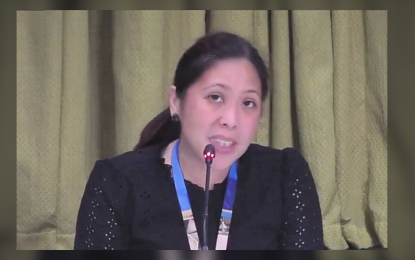
DIGITAL PAYMENT. Rodora Teresa Openiano of the Bangko Sentral ng Pilipinas North Luzon Regional Office urges the public to continue embracing digital financial transactions to be at par with the rest of the world, in a press conference on Wednesday (Oct. 25, 2023). She said 60 percent of merchants in Baguio City now offer digital payment option under the government’s Paleng-QR Ph Plus program. (PNA photo by Liza Agoot)
BAGUIO CITY – Sixty percent of business owners in this city’s public market now offer digital payment options, an executive of the Bangko Sentral ng Pilipinas said Wednesday.
In a press conference, BSP North Luzon Regional Office bank officer Rodora Teresa Openiano said electronic wallet (e-wallet) service providers like GCash and PayMaya have reported continued increase in the number of businesses offering digital payment using quick response (QR) code.
Paleng-QR Ph, which has been expanded into Paleng-QR Ph Plus to include more participants, was piloted in this city in 2022 as part of the central bank’s initiative, with the help of the Department of the Interior and Local Government, to boost digital payments in the country.
Openiano said businesses offering QR codes are registered with their choice of financial service provider, have QR codes displayed on their stores and accept QR code as option of payments.
She said this payment system is a “good option” because Baguio City, being a tourist destination, attracts a lot of visitors, some of whom do not carry a lot of cash with them.
“That’s really one way to utilize digital payment. So, pag nag-offer po kayo ng option, madali pong makakapagbayad sa inyo yung inyong mga mamimili (That’s really one way to utilize digital payments. So, when you offer payment options, your customers can easily pay you),” she said.
Citing a nationwide survey of the central bank in 2021, Openiano said there were 27.5 million Filipinos who have opened online financial accounts with different companies.
The same survey showed that 56 percent of adults in the country, or about 42.9 million individuals, have online financial accounts, higher than the 20.9 million Filipinos or 29 percent based on similar survey done in 2019, she said.
Openiano said bulk of these are electronic money (e-money) accounts, with 27.5 million owners, while the balance is accounted for by owners of bank accounts.
She said their assessment on the higher number of e-money accounts points to owners using the accounts for payments and not simply for saving.
Digital retail payments in the country as of 2022 accounted for 42.1 percent of the total, she said.
“So talagang ito pong digital payments, hindi po ito yung pinag-uusapan natin na maaaring mangyari in the future. It is here in the present, it is here and now. (Digital payment is not what we talk about happening in the future. It is here in the present. It is here and now),” she added.
The BSP targets to increase the share of digital payments to 50 percent of the total by end-2023. (PNA)
